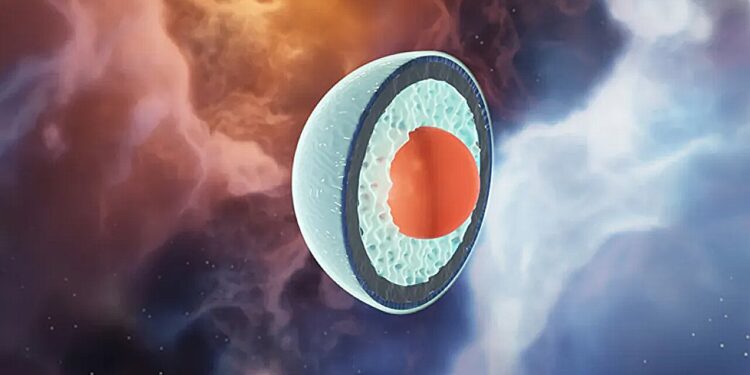Artist’s impression of the different layers inside a massive neutron star, the red circle representing a large core of quarks and matter. Credit: Jyrki Hokkanen, SCC
The cores of neutron stars contain matter at the highest densities achieved in our current universe, with up to two solar masses of matter compressed into a sphere 25 km in diameter. These astrophysical objects can in fact be thought of as giant atomic nuclei, whose gravity compresses their cores to densities many times greater than those of individual protons and neutrons.
These densities make neutron stars interesting astrophysical objects from the point of view of particle physics and nuclear physics. A long-standing open problem is whether the immense central pressure of neutron stars can squeeze protons and neutrons into a new phase of matter, known as cold quark matter. In this exotic state of matter, individual protons and neutrons no longer exist.
“The quarks and gluons that constitute them are released from their typical color confinement and can move almost freely,” explains Aleksi Vuorinen, professor of theoretical particle physics at the University of Helsinki.
A strong phase transition can still ruin the day
In a new article published in Natural communications, a team based at the University of Helsinki has provided the first-ever quantitative estimate of the likelihood of the presence of quark nuclei and matter inside massive neutron stars. They showed that, based on current astrophysical observations, quark matter is almost inevitable in the most massive neutron stars: a quantitative estimate extracted by the team places the probability between 80 and 90 percent.
The remaining low probability that all neutron stars are composed only of nuclear matter requires that the transition from nuclear to quark matter be a strong first-order phase transition, somewhat resembling that of liquid water transforming in ice. This type of rapid change in the properties of a neutron star’s matter has the potential to destabilize the star in such a way that the formation of even a tiny core of quark matter would cause the star to collapse. star into a black hole.
The international collaboration between scientists from Finland, Norway, Germany and the United States helped show how the existence of quark nuclei and matter could one day be fully confirmed or disproved. The key is to be able to limit the strength of the phase transition between nuclear matter and quark matter, which should be possible once a gravitational wave signal from the last part of a binary merger of neutron stars will one day be recorded.
Massive supercomputer runs using observational data
A key ingredient in obtaining the new results was a set of massive supercomputer calculations using Bayesian inference, a branch of statistical deduction where one infers the probabilities of different model parameters via direct comparison with observational data .
The Bayesian component of the study allowed researchers to derive new limits for the properties of neutron star matter, demonstrating that they approximate so-called conformal behavior near the cores of the most massive stable neutron stars.
Dr. Joonas Nättilä, one of the lead authors of the paper, describes the work as an interdisciplinary effort requiring expertise in astrophysics, particle and nuclear physics, as well as computer science. He is about to start as an associate professor at the University of Helsinki in May 2024.
“It is fascinating to see in practice how each new neutron star observation allows us to infer the properties of neutron star matter with increasing precision.”
Joonas Hirvonen, Ph.D. student working under the direction of Nättilä and Vuorinen, on the other hand emphasizes the importance of high-performance computing:
“We had to use millions of hours of calculation on a supercomputer to be able to compare our theoretical predictions with observations and limit the probability of quark-matter nuclei. We are extremely grateful to the Finnish supercomputer center CSC for providing us with all the necessary resources. We needed!”
More information:
Eemeli Annala et al, Strongly interacting matter exhibits deconfined behavior in massive neutron stars, Natural communications (2023). DOI: 10.1038/s41467-023-44051-y
Provided by the University of Helsinki
Quote: Further evidence for the presence of quark nuclei and matter in massive neutron stars (December 28, 2023) retrieved December 28, 2023 from
This document is subject to copyright. Apart from fair use for private study or research purposes, no part may be reproduced without written permission. The content is provided for information only.



